The Whirlpool Galaxy, aka M51, is one of the most well-known objects in the night sky. It’s close enough and prominent in the northern sky that amateur astronomers have shared stunning pictures of it for decades. But you’ve never seen anything like this: M51 as seen by the James Webb Space Telescope (JWST). This image contains data from the telescope’s NIRCam and MIRI instruments, which shows incredible detail and reveals hidden features among the spiral arms.
The galaxy is nicknamed the Whirlpool because of its swirling structure, which resembles water circling a drain. Like other grand-design spiral galaxies, the twisting spiral arms show up prominently.

The integrated data from JWST’s Near-InfraRed Camera (NIRCam) and the Mid-InfraRed Instrument (MIRI) reveals the warm dust that concentrates along the spiral arms which shows up as the dark red regions. The bright areas along the arms are star forming regions which lead down to the blue and white central core. The orange and yellow areas show regions of ionized gas created by recently formed star clusters. Then, JWST reveals there are the cavernous black bubbles within the arms, which allow us to almost see through the gas and dust of the galaxy to distant stars, as never before.
The Whirlpool Galaxy is located 31 million light-years away in the constellation Canes Venatici.

In other images, like this one from the Hubble Space Telescope, a small, yellowish galaxy at the outermost tip of one of the Whirlpool’s arms is visible. This is NGC 5195 and the two galaxies are interacting. Even though it is much smaller than the Whirlpool, NGC 5195’s gravitational influence is thought to be partially responsible for the Whirlpool’s prominent and distinct spiral arms.
This JWST observation of M51 was performed as part of a series of observations called Feedback in Emerging extrAgalactic Star clusTers, or FEAST. The FEAST observations were designed to “shed light on the interplay between stellar feedback and star formation in environments outside of our own galaxy, the Milky Way,” according to ESA. Stellar feedback is the term used to describe the outpouring of energy from stars into the environments which form them, and is a crucial process in determining the rates at which stars form. Scientists say that understanding stellar feedback is vital to building accurate universal models of star formation.


